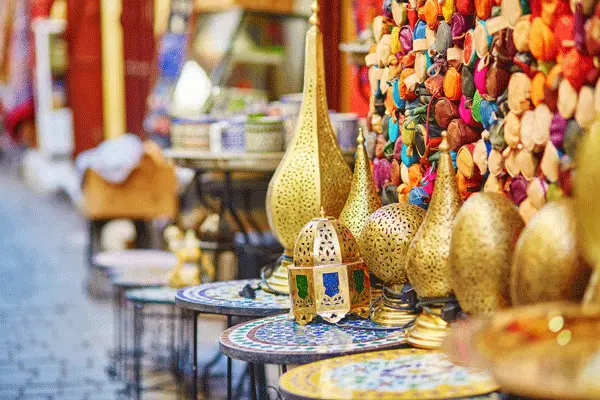No trip to Morocco is complete without diving headfirst into the vibrant, chaotic, and utterly captivating world of a traditional Moroccan souk. These sprawling marketplaces are the lifeblood of the ancient medinas, a sensory overload of sights, sounds, and smells where you can find everything from exquisite Moroccan handicrafts to aromatic spices. This guide will teach you how to navigate the souks of Marrakech and beyond, what treasures to look for, and most importantly, how to master the art of bargaining.
What is a Souk? Understanding the Moroccan Market
A souk is a traditional open-air market, a labyrinth of narrow alleyways packed with small shops and artisan workshops. Historically, souks were organized by trade, and you can still see remnants of this today, with sections dedicated to leatherworkers (Souk Cherratine), metalworkers (Souk Haddadine), and dyers (Souk des Teinturiers). The Marrakech market, particularly the area around Jemaa el-Fnaa, is the most famous, but every city and town has its own unique souk waiting to be explored.
Top 10 Things to Buy in Morocco
The sheer variety of goods can be overwhelming. Here’s a list of the most iconic and sought-after items to help you decide what to buy in Morocco:
- Leather Goods: From supple babouches (leather slippers) to handbags, belts, and poufs, Moroccan leather is world-renowned. The tanneries of Fes are the most famous place to see the traditional production process.
- Berber Rugs & Carpets: A true investment piece. Each handwoven Berber rug from Morocco tells a story through its intricate patterns and colors, representing the traditions of a specific tribe.
- Metal Lanterns: Intricately punched metal lanterns are a signature Moroccan craft. They cast beautiful, complex shadows and add an exotic touch to any home.
- Spices: The Spice Square (Rahba Kedima) in Marrakech is an aromatic paradise. Stock up on fragrant spices like Ras el Hanout (a complex blend of up to 35 spices), saffron, cumin, and paprika.
- Argan Oil: Native to Morocco, pure argan oil is a fantastic souvenir, used for both culinary and cosmetic purposes. Look for it at women's cooperatives to ensure you're getting the real thing.
- Djellabas & Kaftans: The traditional hooded robes (djellabas) and more ornate kaftans are beautiful and comfortable garments.
- Ceramics: Colorful hand-painted plates, bowls, and tagine pots from cities like Fes and Safi make for beautiful and functional souvenirs.
- Babouches: These traditional leather slippers are a must-buy. You'll find them in every color imaginable, from simple, everyday styles to ornate, sequined versions.
- Mint Tea Sets: Bring the Moroccan tea ceremony home with a beautiful silver-plated teapot, a tray, and a set of colorful tea glasses.
- Moroccan Textiles: Look for beautiful handwoven blankets (often made from cactus silk or wool), throws, and cushions with vibrant Berber patterns.
- Never accept the first price. The initial price offered is always an opening gambit and can be several times the actual value.
- Have a price in mind. Decide what the item is worth to you before you start negotiating.
- Start low. A good rule of thumb is to counter with about one-third to half of the initial asking price and work your way up from there.
- Be polite and smile. A good-natured attitude goes a long way. This is a game, not a fight.
- Be prepared to walk away. This is your most powerful tool. If you can't agree on a price, politely thank the vendor and walk away. Often, they will call you back with a better offer.
- Don't bargain for small items or food. It's generally not done for low-cost items.

The Art of Bargaining: A Friendly Game
Bargaining, or haggling, is an integral part of the souk experience. It’s not a confrontation but a friendly, social interaction. Don't be intimidated; embrace it as part of the fun!
Tips for Successful Haggling:
"I was so nervous to go shopping in the souks, but it was the most fun I had in Marrakech! I bought a beautiful leather bag and two lanterns. The key really is to smile, be patient, and not be afraid to walk away. I got a great price in the end and had a lovely chat with the shopkeeper."
FAQ: Shopping in the Souks
How do I know if I'm getting a good price?
It takes practice. A good strategy is to browse a few shops selling similar items to get a feel for the starting prices. Ultimately, a "good price" is a price you are happy to pay for the item you love.
Is it better to pay in cash or with a card?
Cash (Moroccan Dirhams) is king in the souks, especially for smaller purchases. While some larger, more established shops will accept credit cards, you will always have more bargaining power with cash.
What is a 'souk des teinturiers'?
This translates to the "Dyers' Souk." It's the area of the medina where wool, leather, and textiles are dyed. In Marrakech, you can see colorful skeins of yarn hanging out to dry, creating a beautiful and photogenic scene.